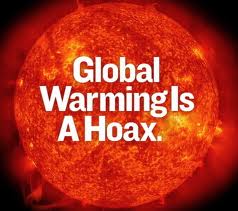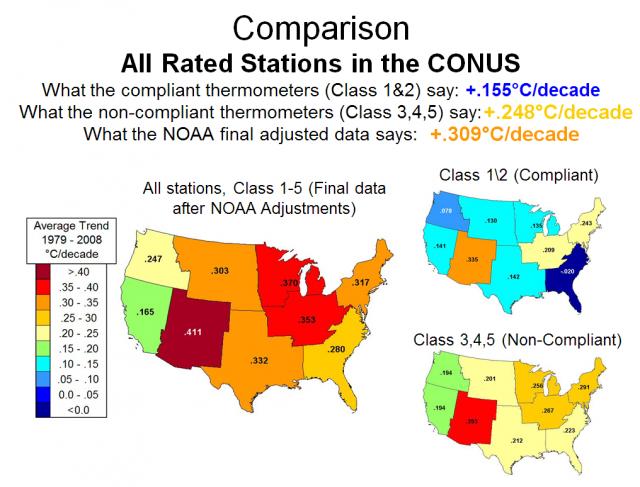New study shows half of the global warming in the USA is artificial
These factors, combined with station siting issues, have led to a spurious doubling of U.S. mean temperature trends in the 30 year data period covered by the study from 1979 – 2008.

A comparison and summary of trends is shown from the paper. Acceptably placed thermometers away from common urban influences read much cooler nationwide:

A reanalysis of U.S. surface station temperatures has been performed using the recently WMO-approved Siting Classification System devised by METEO-France’s Michel Leroy. The new siting classification more accurately characterizes the quality of the location in terms of monitoring long-term spatially representative surface temperature trends. The new analysis demonstrates that reported 1979-2008 U.S. temperature trends are spuriously doubled, with 92% of that over-estimation resulting from erroneous NOAA adjustments of well-sited stations upward. The paper is the first to use the updated siting system which addresses USHCN siting issues and data adjustments.
The new improved assessment, for the years 1979 to 2008, yields a trend of +0.155C per decade from the high quality sites, a +0.248 C per decade trend for poorly sited locations, and a trend of +0.309 C per decade after NOAA adjusts the data. This issue of station siting quality is expected to be an issue with respect to the monitoring of land surface temperature throughout the Global Historical Climate Network and in the BEST network.
Today, a new paper has been released that is the culmination of knowledge gleaned from five years of work by Anthony Watts and the many volunteers and contributors to the SurfaceStations project started in 2007.
This pre-publication draft paper, titled An area and distance weighted analysis of the impacts of station exposure on the U.S. Historical Climatology Network temperatures and temperature trends, is co-authored by Anthony Watts of California, Evan Jones of New York, Stephen McIntyre of Toronto, Canada, and Dr. John R. Christy from the Department of Atmospheric Science, University of Alabama, Huntsville, is to be submitted for publication.
The pre-release of this paper follows the practice embraced by Dr. Richard Muller, of the Berkeley Earth Surface Temperature project in a June 2011 interview with Scientific American’s Michael Lemonick in “Science Talk”, said:
I know that is prior to acceptance, but in the tradition that I grew up in (under Nobel Laureate Luis Alvarez) we always widely distributed “preprints” of papers prior to their publication or even submission. That guaranteed a much wider peer review than we obtained from mere referees.
The USHCN is one of the main metrics used to gauge the temperature changes in the United States. The first wide scale effort to address siting issues, Watts, (2009), a collated photographic survey, showed that approximately 90% of USHCN stations were compromised by encroachment of urbanity in the form of heat sinks and sources, such as concrete, asphalt, air conditioning system heat exchangers, roadways, airport tarmac, and other issues. This finding was backed up by an August 2011 U.S. General Accounting Office investigation and report titled: Climate Monitoring: NOAA Can Improve Management of the U.S. Historical Climatology Network
All three papers examining the station siting issue, using early data gathered by the SurfaceStations project, Menne et al (2010), authored by Dr. Matt Menne of NCDC, Fall et al, 2011, authored by Dr. Souleymane Fall of Tuskeegee University and co-authored by Anthony Watts, and Muller et al 2012, authored by Dr. Richard Muller of the University of California, Berkeley and founder of the Berkeley Earth Surface Temperature Project (BEST) were inconclusive in finding effects on temperature trends used to gauge the temperature change in the United States over the last century.
Lead author of the paper, Anthony Watts, commented:
“I fully accept the previous findings of these papers, including that of the Muller et al 2012 paper. These investigators found exactly what would be expected given the siting metadata they had. However, the Leroy 1999 site rating method employed to create the early metadata, and employed in the Fall et al 2011 paper I co-authored was incomplete, and didn’t properly quantify the effects.
The new rating method employed finds that station siting does indeed have a significant effect on temperature trends.”
Watts et al 2012 has employed a new methodology for station siting, pioneered by Michel Leroy of METEOFrance in 2010, in the paper Leroy 2010, and endorsed by the World Meteorological Organization (WMO) Commission for Instruments and Methods of Observation (CIMO-XV, 2010) Fifteenth session, in September 2010 as a WMO-ISO standard, making it suitable for reevaluating previous studies on the issue of station siting.
Previous papers all used a distance only rating system from Leroy 1999, to gauge the impact of heat sinks and sources near thermometers. Leroy 2010 shows that method to be effective for siting new stations, such as was done by NCDC adopting Leroy 1999 methods with their Climate Reference Network (CRN) in 2002 but ineffective at retroactive siting evaluation.
Leroy 2010 adds one simple but effective physical metric; surface area of the heat sinks/sources within the thermometer viewshed to quantify the total heat dissipation effect.
Using the new Leroy 2010 classification system on the older siting metadata used by Fall et al. (2011), Menne et al. (2010), and Muller et al. (2012), yields dramatically different results.
Using Leroy 2010 methods, the Watts et al 2012 paper, which studies several aspects of USHCN siting issues and data adjustments, concludes that:
These factors, combined with station siting issues, have led to a spurious doubling of U.S. mean temperature trends in the 30 year data period covered by the study from 1979 – 2008.
Other findings include, but are not limited to:
· Statistically significant differences between compliant and non-compliant stations exist, as well as urban and rural stations.
· Poorly sited station trends are adjusted sharply upward, and well sited stations are adjusted upward to match the already-adjusted poor stations.
· Well sited rural stations show a warming nearly three times greater after NOAA adjustment is applied.
· Urban sites warm more rapidly than semi-urban sites, which in turn warm more rapidly than rural sites.
· The raw data Tmean trend for well sited stations is 0.15°C per decade lower than adjusted Tmean trend for poorly sited stations.
· Airport USHCN stations show a significant differences in trends than other USHCN stations, and due to equipment issues and other problems, may not be representative stations for monitoring climate.
We will continue to investigate other issues related to bias and adjustments such as TOBs in future studies.
FILES:
This press release in PDF form: Watts_et_al 2012_PRESS RELEASE (PDF)
The paper in draft form: Watts-et-al_2012_discussion_paper_webrelease (PDF)
The Figures for the paper: Watts et al 2012 Figures and Tables (PDF)
A PowerPoint presentation of findings with many additional figures is available online:
Overview of the paper (PPT)
Methodology – Graphs Presentation (.PPT)
Some additional files may be added as needed.
Contact:
Anthony Watts at: http://wattsupwiththat.com/about-wuwt/contact-2/
References:
GAO-11-800 August 31, 2011, Climate Monitoring: NOAA Can Improve Management of the U.S. Historical Climatology Network Highlights Page (PDF) Full Report (PDF, 47 pages) Accessible Text Recommendations (HTML)
Fall, S., Watts, A., Nielsen‐Gammon, J. Jones, E. Niyogi, D. Christy, J. and Pielke, R.A. Sr., 2011, Analysis of the impacts of station exposure on the U.S. Historical Climatology Network temperatures and temperature trends, Journal of Geophysical Research, 116, D14120, doi:10.1029/2010JD015146, 2011
Leroy, M., 1999: Classification d’un site. Note Technique no. 35. Direction des Systèmes d’Observation, Météo-France, 12 pp.
Leroy, M., 2010: Siting Classification for Surface Observing Stations on Land, Climate, and Upper-air Observations JMA/WMO Workshop on Quality Management in Surface, Tokyo, Japan 27-30 July 2010 http://www.jma.go.jp/jma/en/Activities/qmws_2010/CountryReport/CS202_Leroy.pdf
Menne, M. J., C. N. Williams Jr., and M. A. Palecki, 2010: On the reliability of the U.S. surface temperature record, J. Geophys. Res., 115, D11108, doi:10.1029/2009JD013094
Muller, R.A., Curry, J., Groom, D. Jacobsen, R.,Perlmutter, S. Rohde, R. Rosenfeld, A., Wickham, C., Wurtele, J., 2012: Earth Atmospheric Land Surface Temperature and Station Quality in the United States. http://berkeleyearth.org/pdf/berkeley-earth-station-quality.pdf
Watts, A., 2009: Is the U.S. surface temperature record reliable? Published online at: http://wattsupwiththat.files.wordpress.com/2009/05/surfacestationsreport_spring09.pdf
World Meteorological Organization Commission for Instruments and Methods of Observation, Fifteenth session, (CIMO-XV, 2010) WMO publication Number 1064, available online at: http://www.wmo.int/pages/prog/www/CIMO/CIMO15-WMO1064/1064_en.pdf
Notes:
1. The SurfaceStations project was a crowd sourcing project started in June 2007, done entirely with citizen volunteers (over 650), created in response to the realization that very little physical site survey metadata exists for the entire United States Historical Climatological Network (USHCN) and Global Historical Climatological Network (GHCN) surface station records worldwide. This realization came about from a discussion of a paper and some new information that occurred on Dr. Roger Pielke Sr. Research Group Weblog. In particular, a thread regarding the paper: Pielke Sr., R.A., C. Davey, D. Niyogi, S. Fall, J. Steinweg-Woods, K. Hubbard, X. Lin, M. Cai, Y.-K. Lim, H. Li, J. Nielsen-Gammon, K. Gallo, R. Hale, R. Mahmood, R.T. McNider, and P. Blanken, 2007: Unresolved issues with the assessment of multi-decadal global land surface temperature trends. J. Geophys. Res.
2. Some files in the initial press release had some small typographical errors. These have been corrected. Please click on links above for new press release and figures files.
Help Make A Difference By Sharing These Articles On Facebook, Twitter And Elsewhere:
